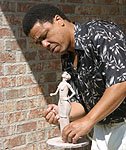First glances into Harold W. Miller's living room suggests that the man is a great collector. The walls and fixtures feature paintings in various styles, reliefs, intricately designed urns, figurines from pint-size to life-size, sculpture, jewelry and even a decorative steer head, all executed with impeccable taste and craft. Despite first impressions, these various pieces are all Miller's own work.
Miller, 48, is a full-time artist who got his start at 6 years old working with the clay from the banks of the river near his mother's house in Vicksburg. He and his brother have since built a studio behind that same house, and he travels there from his current home in Brandon periodically to do work and retrieve pieces from storage that he wants to sell at his next exhibit. But most of the time, Miller sits on his back patio and does his work on the sculpting table he made for himself out of an old stool. He says he prefers this area (when the weather permits) to his "real" studio in the garage.
Miller will proudly tell you he holds no degrees, though he studied pottery at Hinds under Russell Snyder and has taken continuing education courses to cultivate the basics of his craft. Training or not, Miller is obviously a keen businessman as well as an impressive artist. A member of the board of the Mississippi Craftsmen's Guild, Miller is also on the Mississippi Arts Commission's Roster and does major arts shows from Atlanta to L.A., as well as more local shows like the Chimneyville Crafts Festival, and carefully selects his wares based on the crowd that each event draws.
"If I'm doing Chimneyville, I want to take more Southern pieces, like this—this is a Chimneyville sale," he says, referring to a sculpture he picks up, about 8 inches high, of an African-American woman in a headwrap on her knees praying. "This would not sell in Atlanta," he says of the same piece.
He characterizes so-called "Atlanta sales" as more ethnic pieces, featuring a rich cultural history of blacks from Africa to America. One vase that falls into this category depicts kings at the bottom and, at the top, slaves crammed into a slave ship, showing the degradation that occurred on the voyages between Africa and America. Another vase, a continuation of the first, has slaves at the bottom, with gods and prayer in the middle helping them get back to being kings again at the top.
Some upper-middle-class black clients have shied away from Miller's statues depicting black subjects doing housework or praying, but he says he's telling the story—all of it. "Artists have an obligation to leave a message—it's our job. You've got to tell the truth in the work." To ignore black women doing housework in his art would be, essentially, to ignore what he saw in his childhood. "The women who worked babysitting and kitchen jobs when I was younger—they're the ones who sent their kids to college," he says.
"I am a working artist," Miller says earnestly. Shows, workshops and exhibits are his sole sources of income, and as a full-time artist, he has to be able to take the good with the bad. When he gives workshops for school-aged children through the Mississippi Arts Council and hears one of them say they want to be an artist, he tells them to think long and hard about it first. "It's not for everybody," he says. "Everybody can't stand the pain, but the pure joy of doing it compensates for the hard times."



Comments
Use the comment form below to begin a discussion about this content.